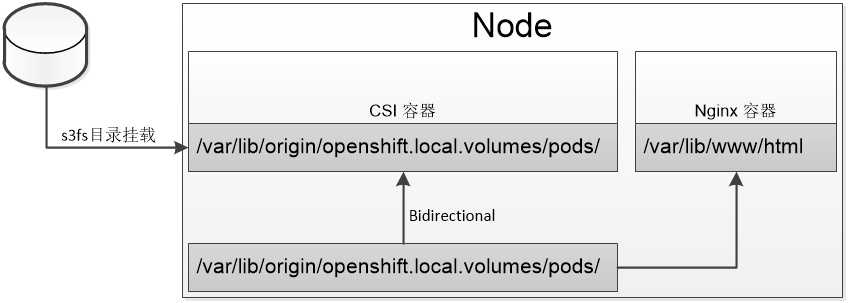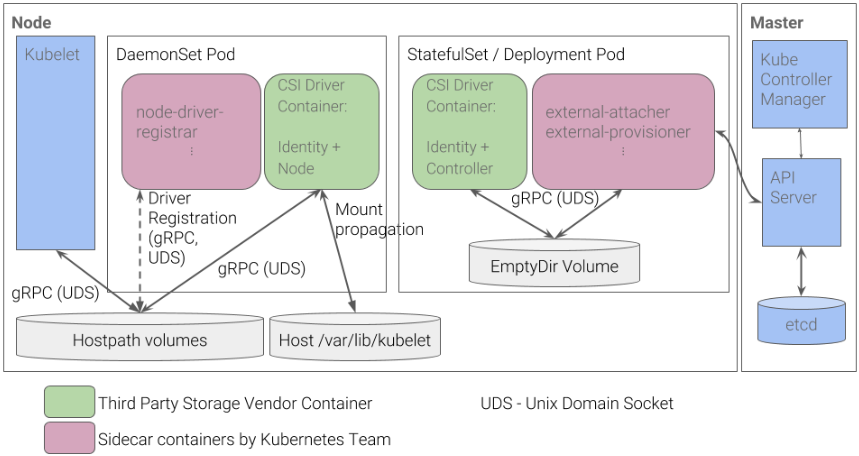基于openshift+华为对象存储的CSI开发
需求来源
项目上目前使用的是openshift 3.11版本,对应kubernetes 1.11,需要在该平台上使用CSI插件。
GitHub地址:https://github.com/woodliu/csi-s3
环境准备
-
本次使用openshift 3.11,对应kubernetes 1.11,参考github开源代码ctrox/csi-s3进行开发(强烈建议使用的kubernetes不低于1.13)。
-
部署中涉及如下sidecar容器:csi-attacher,csi-node-driver-registrar,csi-provisioner,csi-s3。最后一个容器是需要开发的CSI插件,其他sidecar版本需要与kubernetes配套才能使用,参照官方开发文档找到合适的版本,例如符合kubernetes 1.11版本的csi-attacher版本为0.42。除csi-s3之外的镜像都可以从官方镜像库中下载。
-
CSI spec规定了protobuf格式的存储相关的数据结构,本次应该采用v0.3.0版本。按照官方说法,kubernetes1.13中废弃了CSI spec 0.2和0.3版本。
Kubernetes CSI Spec Compatibility Status v1.9 v0.1.0 Alpha v1.10 v0.2.0 Beta v1.11 v0.3.0 Beta v1.13 v0.3.0, v1.0.0 GA -
下载华为OBS对象存储Go语言SDK。
-
docker 17.05+(使用multi-stage生成镜像)
代码修改
主要是使用华为OBS的SDK操作替换代码中对bucket的操作等。涉及修改的代码文件为pkg/s3/controllerserver.go,nodeserver.go,s3-client.go
镜像下载
docker pull quay.io/k8scsi/csi-attacher:v0.4.2
docker pull quay.io/k8scsi/driver-registrar:v0.4.2
docker pull quay.io/k8scsi/csi-provisioner:v0.4.2
镜像生成
在/csi-s3目录中执行如下命令可以在/csi-s3/_output/目录中生成可执行文件s3driver
make build
在/csi-s3目录下执行如下命令生成镜像
make container
修改部署文件
-
修改storageclass
ctrox/csi-s3目录中的deploy/kubernetes/storageclass.yaml内容如下,mounter使用s3fs,由于仅使用
s3fsMounterType类型,因此无需指定StorageClass.mounter字段kind: StorageClass apiVersion: storage.k8s.io/v1 metadata: name: csi-s3 provisioner: ch.ctrox.csi.s3-driver parameters: # specify which mounter to use # can be set to rclone, s3fs, goofys or s3backer csiProvisionerSecretName: csi-s3-secret csiProvisionerSecretNamespace: kube-system csiControllerPublishSecretName: csi-s3-secret csiControllerPublishSecretNamespace: kube-system csiNodeStageSecretName: csi-s3-secret csiNodeStageSecretNamespace: kube-system csiNodePublishSecretName: csi-s3-secret csiNodePublishSecretNamespace: kube-system其中
parameters字段的内容在1.0.1版本进行了修改,因此小于1.0版本的prvisioner采用左边的声明。Deprecated Replacement csiProvisionerSecretName csi.storage.k8s.io/provisioner-secret-name csiProvisionerSecretNamespace csi.storage.k8s.io/provisioner-secret-namespace csiControllerPublishSecretName csi.storage.k8s.io/controller-publish-secret-name csiControllerPublishSecretNamespace csi.storage.k8s.io/controller-publish-secret-namespace csiNodeStageSecretName csi.storage.k8s.io/node-stage-secret-name csiNodeStageSecretNamespace csi.storage.k8s.io/node-stage-secret-namespace csiNodePublishSecretName csi.storage.k8s.io/node-publish-secret-name csiNodePublishSecretNamespace csi.storage.k8s.io/node-publish-secret-namespace fstype csi.storage.k8s.io/fstype -
修改secret.yaml,特别注意
endpoint字段不能省略http或httpsapiVersion: v1 kind: Secret metadata: name: csi-s3-secret stringData: accessKeyID: ${AK} secretAccessKey: ${SK} # For AWS set it to "https://s3.<region>.amazonaws.com" endpoint: http://obs.${mycloud}.com # If not on S3, set it to "" region: <S3_REGION> -
修改csi-s3.yaml,将容器卷挂载地址修改为
/var/lib/origin/openshift.local.volumes/pods/ -
修改各个配置文件中的镜像仓库和版本
部署CSI插件
部署组件
cd deploy/kubernetes
kubectl create -f provisioner.yaml
kubectl create -f attacher.yaml
kubectl create -f csi-s3.yaml
部署storageclass
kubectl create -f storageclass.yaml
测试,创建一个pvc
kubectl create -f pvc.yaml
查看该pvc是否已经绑定
# oc get pvc
NAME STATUS VOLUME CAPACITY ACCESS MODES STORAGECLASS AGE
csi-s3-pvc Bound pvc-ea844fa4-6f64-11ea-8eab-fa163e07eb1d 5Gi RWO csi-s3 30m
创建一个pod,查看该pod是否运行成功,并在该pod挂载的目录/var/lib/www/html下创建文件,看对象存储那端是否有新的文件生成。
oc create -f pod.yaml
CSI原理
核心原理
CSI的核心原理比较简单,见下图。基本原理就是启动一个CSI容器(自己写的插件),将Node主机上的/var/lib/origin/openshift.local.volumes/pods/目录(该目录包含所有Pod的卷挂载点)挂载到CSI容器内部的/var/lib/origin/openshift.local.volumes/pods/目录下。然后调用s3fs命令将对象存储挂载到/var/lib/origin/openshift.local.volumes/pods/${POD_ID}/volumes/kubernetes.io~csi/${PV_NAME}/mount目录下,而/var/lib/origin/openshift.local.volumes/pods/${POD_ID}/volumes/kubernetes.io~csi/${PV_NAME}/mount就是对应容器挂载PVC对应的node节点上的挂载点。对象存储的BUCKET_NAME与PV_NAME相同。
总之整个过程涉及三次挂载:将应用容器在Node节点上的目录挂载到CSI容器中;将后端存储挂载到CSI容器中;将应用容器在Node节点上的目录挂载到应用容器中。
s3fs ${BUCKET_NAME}:/csi-fs /var/lib/origin/openshift.local.volumes/pods/${POD_ID}/volumes/kubernetes.io~csi/${PV_NAME}/mount -o use_path_request_style -o url=http://obs.${mycloud}.com -o allow_other -o mp_umask=000

生命周期:
CSI插件的运作流程需要符合卷的生命周期特性,官方给出的生命周期如下:
CreateVolume +------------+ DeleteVolume
+------------->| CREATED +--------------+
| +---+----^---+ |
| Controller | | Controller v
+++ Publish | | Unpublish +++
|X| Volume | | Volume | |
+-+ +---v----+---+ +-+
| NODE_READY |
+---+----^---+
Node | | Node
Publish | | Unpublish
Volume | | Volume
+---v----+---+
| PUBLISHED |
+------------+
Figure 5: The lifecycle of a dynamically provisioned volume, from
creation to destruction.
CreateVolume +------------+ DeleteVolume
+------------->| CREATED +--------------+
| +---+----^---+ |
| Controller | | Controller v
+++ Publish | | Unpublish +++
|X| Volume | | Volume | |
+-+ +---v----+---+ +-+
| NODE_READY |
+---+----^---+
Node | | Node
Stage | | Unstage
Volume | | Volume
+---v----+---+
| VOL_READY |
+---+----^---+
Node | | Node
Publish | | Unpublish
Volume | | Volume
+---v----+---+
| PUBLISHED |
+------------+
Figure 6: The lifecycle of a dynamically provisioned volume, from
creation to destruction, when the Node Plugin advertises the
STAGE_UNSTAGE_VOLUME capability.
Controller Controller
Publish Unpublish
Volume +------------+ Volume
+------------->+ NODE_READY +--------------+
| +---+----^---+ |
| Node | | Node v
+++ Publish | | Unpublish +++
|X| <-+ Volume | | Volume | |
+++ | +---v----+---+ +-+
| | | PUBLISHED |
| | +------------+
+----+
Validate
Volume
Capabilities
Figure 7: The lifecycle of a pre-provisioned volume that requires
controller to publish to a node (`ControllerPublishVolume`) prior to
publishing on the node (`NodePublishVolume`).
+-+ +-+
|X| | |
+++ +^+
| |
Node | | Node
Publish | | Unpublish
Volume | | Volume
+---v----+---+
| PUBLISHED |
+------------+
Figure 8: Plugins MAY forego other lifecycle steps by contraindicating
them via the capabilities API. Interactions with the volumes of such
plugins is reduced to `NodePublishVolume` and `NodeUnpublishVolume`
calls.
可以看到,并不需要实现controller(见下)中的所有功能,只需按照需要实现即可。
组件介绍
官方架构如下,主要分为两部分:DeamonSet Pod和Statefulset/Deployment Pod ,前者负责各个Node节点上的卷的挂载;后者负责操作后端存储并与API Server交互。

官方提供了两个很好的文档:Container Storage Interface (CSI)和CSI Volume Plugins in Kubernetes Design Doc。前者给出了开发涉及的接口,后者给出了内部原理。
CSI需要实现3个RPC服务
- Identity Service: 允许容器编排系统像插件获取capabilities, health(probe), 和其他元数据
- Controller Service: 见下文Controller接口的介绍
- Node Service:见下文Node接口的介绍:
在CSI执行前需要调用如下接口注册对应的组件,各个组件需要实现对应的接口(见下文):
func (s *Server) RegisterService(sd *ServiceDesc, ss interface{})
func (s *Server) RegisterService(sd *ServiceDesc, ss interface{})
func (s *Server) RegisterService(sd *ServiceDesc, ss interface{})
service Identity {
rpc GetPluginInfo(GetPluginInfoRequest)
returns (GetPluginInfoResponse) {}
rpc GetPluginCapabilities(GetPluginCapabilitiesRequest)
returns (GetPluginCapabilitiesResponse) {}
rpc Probe (ProbeRequest)
returns (ProbeResponse) {}
}
service Controller {
rpc CreateVolume (CreateVolumeRequest)
returns (CreateVolumeResponse) {}
rpc DeleteVolume (DeleteVolumeRequest)
returns (DeleteVolumeResponse) {}
rpc ControllerPublishVolume (ControllerPublishVolumeRequest)
returns (ControllerPublishVolumeResponse) {}
rpc ControllerUnpublishVolume (ControllerUnpublishVolumeRequest)
returns (ControllerUnpublishVolumeResponse) {}
rpc ValidateVolumeCapabilities (ValidateVolumeCapabilitiesRequest)
returns (ValidateVolumeCapabilitiesResponse) {}
rpc ListVolumes (ListVolumesRequest)
returns (ListVolumesResponse) {}
rpc GetCapacity (GetCapacityRequest)
returns (GetCapacityResponse) {}
rpc ControllerGetCapabilities (ControllerGetCapabilitiesRequest)
returns (ControllerGetCapabilitiesResponse) {}
rpc CreateSnapshot (CreateSnapshotRequest)
returns (CreateSnapshotResponse) {}
rpc DeleteSnapshot (DeleteSnapshotRequest)
returns (DeleteSnapshotResponse) {}
rpc ListSnapshots (ListSnapshotsRequest)
returns (ListSnapshotsResponse) {}
rpc ControllerExpandVolume (ControllerExpandVolumeRequest)
returns (ControllerExpandVolumeResponse) {}
}
service Node {
rpc NodeStageVolume (NodeStageVolumeRequest)
returns (NodeStageVolumeResponse) {}
rpc NodeUnstageVolume (NodeUnstageVolumeRequest)
returns (NodeUnstageVolumeResponse) {}
rpc NodePublishVolume (NodePublishVolumeRequest)
returns (NodePublishVolumeResponse) {}
rpc NodeUnpublishVolume (NodeUnpublishVolumeRequest)
returns (NodeUnpublishVolumeResponse) {}
rpc NodeGetVolumeStats (NodeGetVolumeStatsRequest)
returns (NodeGetVolumeStatsResponse) {}
rpc NodeExpandVolume(NodeExpandVolumeRequest)
returns (NodeExpandVolumeResponse) {}
rpc NodeGetCapabilities (NodeGetCapabilitiesRequest)
returns (NodeGetCapabilitiesResponse) {}
rpc NodeGetInfo (NodeGetInfoRequest)
returns (NodeGetInfoResponse) {}
}
下看主要看一下controller中涉及的主要功能:
CreateVolume/DeleteVolume:由provisioner调用,负责后端存储上卷的创建/删除,如对象存储上bucket的创建/删除。provisioner会监控用户创建/删除的PVC,进而操作PVC指定的storageclass。ControllerPublishVolumeResponse/ControllerUnpublishVolume:由attacher调用,负责将远端卷挂载到node节点上。本次实现中,远端卷直接使用s3fs挂载到了csi容器中,因此没有实现该接口,即没有指定ControllerServiceCapability_RPC_PUBLISH_UNPUBLISH_VOLUME。*注:虽然没有实现该接口,但attacher容器必须要部署。- NodeStageVolume/NodeUnstageVolume:由registrar调用,用于处理setup/teardown(初始化设置/清理环境)卷。
- NodePublishVolume/NodeUnpublishVolume:由registrar调用,用于将卷挂载/卸载到应用容器中。
registrar用到了两个UNIX域套接字:- Registration socket:
- 创建reg.sock文件,用于将驱动注册到kubelet
- 通过kubelet插件库路径(通常是
/var/lib/kubelet/plugins_registry/<drivername.example.com>-reg.sock暴露服务
- CSI driver socket:
- 创建sock文件,kubelet用该socket与CSI驱动交互
- 通过kubelet插件库路径(通常是
/var/lib/kubelet/plugins/<drivername.example.com>/csi.sock)暴露服务。
- Registration socket:
NOTE
- 本方式其实是将对象存储转化为文件系统的方式,理论上应该是存在性能损失的
- 更多内容可以参见这篇文章
FAQ
-
pvc创建不成功。这个一般是对后端存储的操作不正确导致的,需要检查controllerserver.go中的代码
-
pv和pvc绑定成功,但容器挂载不成功:
transport endpoint is not connected,可以在对应节点的daemonset pod中csi容器中执行如下命令调试,一般是s3fs命令格式不对导致的。echo ${AK}:${SK} > ${passwd_file} s3fs ${bucket_name} ${target_mount_path} -o url=http://obs.${mycloud}.com -o passwd_file=${passwd} -o dbglevel=info -f -o curldbg -
pv和pvc绑定成功,且容器挂载成功,但对容器挂载目录的变更无法同步到后端存储。需要检查对应node节点上的csi容器中的挂载点是否正确。一般是
spec.template.spec.containers.csi-s3.volumeMounts.pods-mount-dir和spec.template.spec.volumes.pods-mount-dir值不一致导致的
参考:
本文来自博客园,作者:charlieroro,转载请注明原文链接:https://www.cnblogs.com/charlieroro/p/12581405.html





